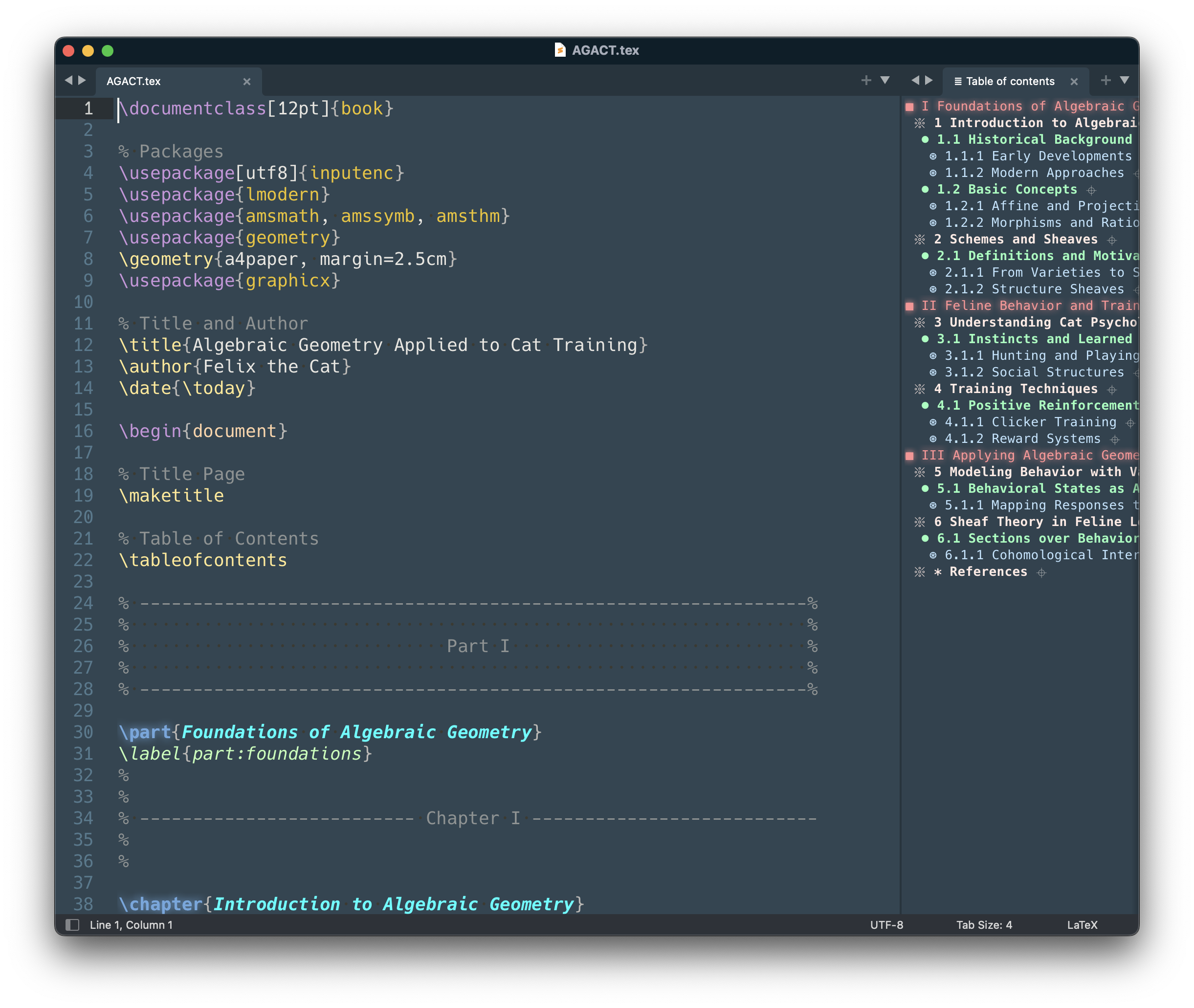LaTeXOutline
A Sublime Text package that displays sections of a LaTeX file on a side tab and gives easy access to references
Details
Installs
- Total 286
- Win 105
- Mac 132
- Linux 49
| Dec 28 | Dec 27 | Dec 26 | Dec 25 | Dec 24 | Dec 23 | Dec 22 | Dec 21 | Dec 20 | Dec 19 | Dec 18 | Dec 17 | Dec 16 | Dec 15 | Dec 14 | Dec 13 | Dec 12 | Dec 11 | Dec 10 | Dec 9 | Dec 8 | Dec 7 | Dec 6 | Dec 5 | Dec 4 | Dec 3 | Dec 2 | Dec 1 | Nov 30 | Nov 29 | Nov 28 | Nov 27 | Nov 26 | Nov 25 | Nov 24 | Nov 23 | Nov 22 | Nov 21 | Nov 20 | Nov 19 | Nov 18 | Nov 17 | Nov 16 | Nov 15 | Nov 14 | Nov 13 | |
|---|---|---|---|---|---|---|---|---|---|---|---|---|---|---|---|---|---|---|---|---|---|---|---|---|---|---|---|---|---|---|---|---|---|---|---|---|---|---|---|---|---|---|---|---|---|---|
| Windows | 0 | 0 | 0 | 1 | 1 | 0 | 1 | 0 | 0 | 4 | 0 | 2 | 1 | 0 | 0 | 0 | 1 | 0 | 1 | 1 | 1 | 0 | 1 | 1 | 1 | 3 | 1 | 1 | 0 | 1 | 3 | 2 | 0 | 1 | 0 | 1 | 2 | 0 | 0 | 2 | 0 | 0 | 0 | 1 | 1 | 1 |
| Mac | 0 | 1 | 0 | 1 | 0 | 1 | 3 | 0 | 0 | 0 | 0 | 3 | 1 | 2 | 0 | 1 | 0 | 0 | 1 | 0 | 2 | 0 | 1 | 0 | 1 | 1 | 3 | 2 | 0 | 0 | 1 | 0 | 1 | 3 | 2 | 1 | 1 | 0 | 3 | 1 | 2 | 0 | 0 | 2 | 1 | 2 |
| Linux | 0 | 0 | 0 | 0 | 0 | 1 | 1 | 0 | 1 | 1 | 0 | 0 | 0 | 0 | 2 | 0 | 1 | 0 | 1 | 1 | 1 | 0 | 0 | 0 | 0 | 0 | 0 | 0 | 1 | 2 | 0 | 0 | 0 | 0 | 2 | 0 | 0 | 0 | 1 | 0 | 1 | 0 | 0 | 0 | 0 | 0 |
Readme
- Source
- raw.githubusercontent.com
LaTeXOutline for Sublime Text
Overview
LaTeXOutline is an ST4 package which allows displaying a clickable table of contents for a LaTeX file. This outline is shown on a separate tab.
It is intended to be used with the article, book and beamer LaTeX classes.
In particular, the captured sectioning commands are: part, chapter, section, subsection, subsubsection, subsubsubsection, paragraph and frametitle.
LaTeXOutline accepts multiple-files .tex documents.

The simplest way to install LaTeXOutline is by using PackageControl. You can also install it manually by following these steps.
Manual installation
- Clone or download this repository using the green
Clone or downloadbutton. - If needed, rename the cloned or extracted folder to
LaTeXOutline. - Move the
LaTeXOutlinefolder to your Sublime Text'sPackagesfolder. - Restart Sublime Text.
- Modify the settings, the keybindings and possibly the
LaTeXOutline-custom.hidden-color-schemeto your liking by going to the menuSettings>Packages Settings>LaTeXOutlineor by using the corresponding Command Palette entries.
Usage
Open a LaTeX File.
Use the command Palette entries
LaTeXOutline: ToC on the Right(orLeft),LaTeXOutline: ToC and labels on the Right(orLeft) to open the outline pane. UseLaTeX Outline: Close sidebarto close it.
Alternatively, use the corresponding shortcuts (by default,ctrl j, a,ctrl j, e,ctrl j, zon windows/linux and⌘ j, a,⌘ j, e,⌘ j, zon mac). See the keybindings settings for more details.Click on the titles in the LaTeXOutline tab to get to the corresponding place in your LaTeX file.
Click on a⌖sign to take a look at a part of the LaTeX file in a panel. UseEscto close the panel.
Click on a❐sign to copy the corresponding label to the clipboard (alt+click on a❐sign copies\ref{label}or\eqref{label}).
Click on a section's bullet in the LaTeXOutline tab to copy the section's corresponding label in the clipboard. A message is given in the status bar below to indicate if this label has been found.
Remarks
- Sections and labels numbering in the outline relies on the
.auxfile and consequently does not work when it is erased. - Gathering environment names may take some time and is performed in the background. As a result, they may appear slightly later in the outline (when the corresponding setting is enabled).
Known issues
- Section numbering does not work with the use of the
cleverefpackage. It is likely that many packages interfering with the.auxfile can create issues as well.
License
This plugin is licensed under the MIT license. In particular, it is provided “as is”, without warranty of any kind!
Acknowledgements
LaTeXOutline is originally a specific adaptation of warmdev's original SublimeOutline to LaTeX files, also using modifications due to vlad-wonderkidstudio, see SublimeOutline. It still uses an appreciable part of this code. LaTeXOutline also borrows code from LaTeXTools.
